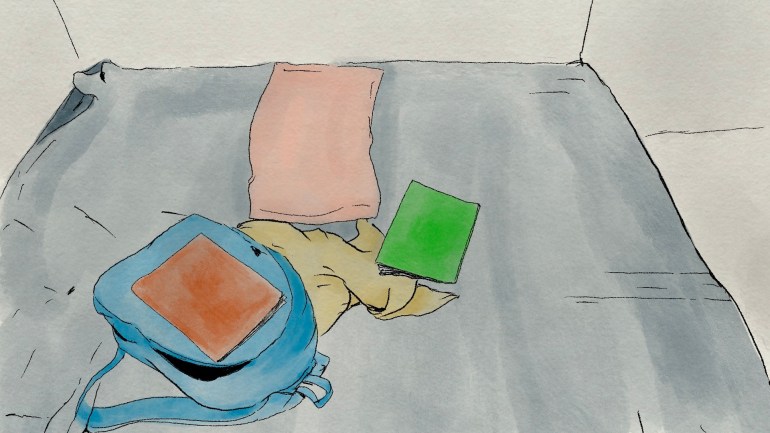Muzaffarpur, India – As protesters took to the streets of Kolkata to demand justice for a trainee doctor who was raped and murdered on August 9, 55-year-old Nirali Kumari* gasped for breath in her small wooden hut 480km (300 miles) away. She hadn’t left her home – or even her bed – since the body of her 14-year-old daughter was found on the morning of August 12 – naked, bloodied and with her hands and legs tied.
Kumari says “six men wielding knives” entered her home on the night of August 11. “[They] threatened us and kidnapped my daughter. She was sleeping right here, with her elder sister,” she adds, before breaking down.
When Al Jazeera first met Kumari, she was so overwhelmed by grief that she had not eaten in the five days since her daughter’s body had been discovered. Her wrist was bloodied and bandaged from the cannula feeding her fluids. She fainted from time to time in the suffocating heat of her hut, even as a relative waved a handheld fan over her.
![[Jawahir Al-Naimi/Al Jazeera]](https://www.aljazeera.com/wp-content/uploads/2024/10/Bed-2-1729864635.jpg?w=770&resize=770%2C433)
Kumari’s daughter’s body was found in a paddy field near her home in the area of Paroo in Muzaffarpur district, Bihar, one of India’s most populous states.
The murder of the teenager – who belonged to the Dalit community, the least privileged in India’s complex caste hierarchy, a position that has enabled its persecution for centuries – has put the entire village on edge.
Kumari’s family lives in a village in Paroo, located nearly 80km (50 miles) from the state capital, Patna. The village is home to fewer than 5,000 people and is surrounded by vast paddy fields. Colourful cement houses belonging to the dominant Yadav community, an estimated 4,500 people, sit on either side of the potholed, date tree-lined main road that runs through the village. Towards the end of the road, 18 grass and bamboo huts house the local Dalit community, which numbers about 80.
A historical system of feudal rule is still a lived reality for millions of people in Bihar, and Paroo is no exception. Across the state, Dalit families depend on dominant caste landlords to earn a living by working on their land for a daily wage. Landowning families often lend money at high interest rates, which can trap families in debt.
In the past, there have been moments of friction between the communities. Last year, during Holi, the Hindu festival of colours, Dalit children crossed over to the “Yadav side” of the village while playing with coloured powders, causing arguments between the communities. The police had to intervene to prevent an escalation, a Dalit resident tells Al Jazeera.
The primary defendant in the murder case, Sanjay Rai, 42, belongs to the Yadav community and is an influential landlord. The men who abducted the girl were masked, but the family identified Rai by his voice and build. The defendant is well-known in the village.
Local media first reported that Kumari’s daughter was gang-raped and murdered after witness accounts and the family reporting the crime to the Paroo police.
Indian law prohibits revealing the identities of victims and their families in sexual violence cases. However, at a news conference on August 19, the police announced they were ruling out rape based on the findings of the postmortem report and the investigation. They also shared that they had arrested Rai and four men from the Dalit community for murder and conspiracy to murder.
The girl’s killing and the authorities’ handling of the case have sparked tension in the village.
Dalit and human rights activists, including some from Paroo, decry the implication of Dalit men, seeing it as the result of pressure and influence from members of the dominant caste to conceal the attackers’ identities and silence their community.
They see the girl’s murder as a clear example of a crime inflicted by the dominant caste on the Dalit community and the case as one resulting from systemic caste oppression.
“Dominant castes have long used [violence, especially] sexual violence, as a tool of oppression. They see themselves as powerful because of their social identity,” says Manjula Pradeep, director of campaigns at the Dalit Human Rights Defenders Network (DHRDN). “Their perception depends on the subjugation of rights of the people from the lower castes.”
![[Jawahir Al-Naimi/Al Jazeera]](https://www.aljazeera.com/wp-content/uploads/2024/10/Two_Women-2-1729864646.jpg?w=770&resize=770%2C433)
‘Kept this family together’
The girl’s schoolbag lay on a wooden bed, and her school dress hung from a plastic hook on the wall. Her elder sister stared at the bag while their mother wailed in the room filled with visitors.
Kumari says her daughter was innocent and sincere. “Just another child,” she says.
“She was beautiful like a flower but also a straight talker,” Kumari recalls, referring to how her daughter would speak up when she felt she needed to. “She was the child who kept this family together. From my medicines to managing our meals, she was young but could do it all.”
The ninth-grade student wanted to complete her high school education, but she often struggled to find time to attend school while helping her parents, both daily-wage labourers, by working in the rice fields and doing chores at home.
Not everyone in the village knew the girl before her killing. But Suraj*, a neighbour of the family who requested his name be changed, fearing repercussions from dominant caste villagers, says Rai has a reputation as “a womaniser”.
Rai had been fixated on the teenager and had pressured her to marry him, the victim’s relatives tell Al Jazeera. “He offered us a tractor and some money,” Kumari explains.
When the girl refused, he harassed the family on the phone.
“I was scared and thought the only way to save my daughter was to marry her off silently,” Kumari says. Even though the legal age for a bride in India is 18, she says she had no choice but to marry her to someone else, a man in his early 20s.
The teenager was set to be married in a nearby village on August 19.
Kumari wailed loudly before fainting again. After a relative splashed her with water, she gasped back to consciousness and broke down.
“Does a Dalit’s life have no value? Or is this country only for the people with money?” she asks. “We want a life for a life.”
![[Jawahir Al-Naimi/Al Jazeera]](https://www.aljazeera.com/wp-content/uploads/2024/10/Field-3-1729864661.jpg?w=770&resize=770%2C433)
‘Dalits are the easiest target’
Sanjay Kumar, 28, navigated the vast maze of the village’s paddy fields under the scorching sun. As he neared where the teenager’s body was found, he grew distressed, speaking falteringly.
He was one of two people who picked up the girl’s body on August 12 in the presence of police officials. He had been working in a paddy field when he heard the shouts and cries of the people who first spotted the body.
“Everyone was terrified just by the sight of the body. I cannot even describe that feeling,” he recalls.
He lives about 80 metres (nearly 90 yards) from the girl’s hut and was shocked when he recognised her face. Then he removed his gamcha, a type of long scarf, to cover her body.
Scratching his shaved head, Kumar says: “Her hands and legs were tied, and she had grave injury marks on her scalp and lower neck.”
These injuries were corroborated in the postmortem report shared by police officials with Al Jazeera. As he lifted the body, Kumar says, he was drenched in blood from the girl’s head and pelvic area. Pelvic injuries were not mentioned in the report.
As a Dalit working as a labourer in Paroo’s paddy fields, Kumar says he has spent his life facing “exploitation” by dominant castes, but this “horrifying incident” has left him jolted.
“Dalits are the easiest target for these men,” he says as his eyes well with tears.
The news that a body had been discovered spread quickly that morning. Kumari had rushed to the field, fearing the worst. The family was not allowed near the girl’s body. All they could see was her face as the police whisked her body away.
In the hours that followed, members of the family had to stand up to local Yadav leaders – who they say pushed for a quick cremation – so they could to register a case with the police and get the investigation started.
Family members say they were able to halt the cremation until later that afternoon after the postmortem had been carried out.
Rushing the cremation of a reported rape and murder victim could be an attempt to destroy “the most important evidence”, Shama Sinha, a lawyer who has represented victims of sexual violence in court, including Dalit women, tells Al Jazeera.
![[Jawahir Al-Naimi/Al Jazeera]](https://www.aljazeera.com/wp-content/uploads/2024/10/Village-1729864656.jpg?w=770&resize=770%2C433)
Increasing crimes and invisibility
According to a DHRDN study, crimes against Dalits, including murder, rose by 177.6 percent over the three decades from 1991 to 2021.
Annual data from India’s National Crime Records Bureau (NCRB) shows there has been a 50 percent increase in murders of Dalits from 651 to 975 from 2012 to 2022, the latest year for which data are available. Bihar has been the second most affected state.
The Indian government does not maintain separate data for crimes against Dalit women and girls such as murder, gang rape and rape with murder. However, NCRB data show a 169 percent increase in reported rapes of Dalit women nationally from 2012 (when there were 1,576 cases) to 2022 (when there were 4,241 cases). An average of 10 Dalit women and girls are reported raped every day.
Pradeep of the DHRDN, a lawyer with more than 30 years of experience navigating cases of violence against women, believes the increase in reported rape partly reflects the growing social mobility of Dalit women.
“The subcastes within Dalits who have been able to climb the economic ladder and assert their rights are also increasingly able to register a complaint,” she says. Even then, she says, the numbers are a “vast undercount”.
Dalit families’ economic reliance on landlords “prevents a lot of complaints”, Pradeep says.
She says crimes against Dalits are often rendered “invisible” due to the community’s disadvantaged social standing.
Sinha, who has spent more than two decades travelling across rural Bihar to run camps to raise awareness about legal rights, agrees.
Fear of retribution is a major factor in low reporting of crimes, she says, “because the next day, these families still have to live in the same village and face the same social dynamics”.
For Dalit women who experience gender discrimination on top of the economic and caste prejudice endured by Dalits, reporting is an even greater challenge.
“The literacy rate is low – 57 percent for Dalit women – and even though there are strong laws in place, there is no awareness and more importantly no agency for [Dalit] women to report [cases] and seek justice,” Sinha says. “Wives still call husbands ‘maalik’,” which is Hindi for “owner”.
This disparity or invisibility extends to representation in media, Pradeep says. “Dalits do not get the same kind of reporting from the media, which could enable social mobilisation.”
The rape and murder of the 31-year-old trainee doctor in Kolkata, a major city in eastern India, prompted nationwide protests and outrage with medical workers in several parts of the country, including Bihar, walking out of hospitals in protest.
There was far less outrage over the murder of the schoolgirl in Paroo although Dalit and women’s rights activists organised protest marches in Bihar.
“Dalit families are left all alone in these times,” Pradeep points out.
![[Jawahir Al-Naimi/Al Jazeera]](https://www.aljazeera.com/wp-content/uploads/2024/10/Protest-1729864650.jpg?w=770&resize=770%2C433)
A playbook
On August 19, Rakesh Kumar, the Muzaffarpur district police chief, said at the news conference that police had arrested Rai that morning from a nearby village as well as the four Dalit men.
Kumar said the victim was not abducted but went willingly to meet Rai near her home when they were attacked by the four men who wanted to punish them for having an intercaste relationship.
He said the men then fled and, panicked, Rai then killed the girl, tied her limbs together and left her body in the fields.
“It [the police version] has to be the most absurd explanation behind the case that reeks with a smell of a cover-up,” says Kumari, a local social activist, who spent a week in the village on a fact-finding mission and requested to be identified only by her second name. “This is straight out of a playbook where the entire machinery is rigged against the community.
“I’m not shocked at all to find Dalit men being arrested in this case. That is what mostly happens in our experience. I would not even be shocked if tomorrow the police implicated one of the family members too if they raise their voice.”
Experts also say rape should not be ruled out.
In court, a range of evidence comes into play in sexual violence cases, Sinha says, and “the signs of rape are harder to catch in medical reports with passing time.”
“Spermatozoa not found” – which is what the report says – can never be grounds to dismiss rape, she says.
Sinha adds that police investigations often suffer from improper collection of time-sensitive evidence and a lack of training of police personnel in investigating cases of sexual violence.
Shreya Rastogi, director of forensics at Project 39A, a New Delhi-based research group, says assuming the forensic report is correct, the absence of sperm does not disprove rape.
She says sperm cells degrade, there may not have been ejaculation and the test could have been done improperly but also the absence of sperm cells “means really nothing because so many scenarios could have occurred while there may still have been penetration. … Ruling out rape is completely wrong.”
She continues: “Both legally and medically speaking, ruling out rape just on the basis of absence of sperm is not valid or reliable.”
Al Jazeera tried to reach Rai as well as his family, who left the village before Rai’s arrest. The details of Rai’s legal counsel are not known.
‘Treated like criminals’
Back at Nirali Kumari’s home, a group of local Yadav leaders came to meet the family on August 17 while Al Jazeera was visiting.
She tried to stay conscious for the visitors, who were given chairs to sit on.
“We should not politicise this issue. One person’s doing does not represent the Yadav community at large,” Tulsi Rai, 43, a local Yadav leader who came to visit the family, tells Al Jazeera.
If someone from the Dalit community told him that they were being intimidated by a Yadav family, “we will scare those Yadavs back,” Rai says. “A filthy person like Sanjay does not belong to our community. We have disowned him.”
But soon, teenage boys and men appeared outside the family’s home wearing blue scarves, synonymous with Dalit politics. They interrupted their words of sympathy and called for accountability.
“We have lost our daughter, but I do not trust the police and the administration for justice and our safety,” Nirali Kumari says. “We only have faith in brothers of our caste across India to help us get justice now.”
Dalit activists held small protests in Paroo, which stirred fear among Dalit families of a backlash from the dominant caste. Then, on the evening of August 18, the Kumari family was forced to flee the village.
Nirali Kumari says they left behind an unlocked home and all their belongings – including a “hard-earned” bicycle, clothing and food – and “ran for our lives” when, the family says, dominant caste members wielding weapons started ransacking Dalit homes.
“If you survive – come back someday to collect your belongings,” a neighbour told Nirali.
All of the Dalit families have since fled the village, and their 18 huts are now deserted.
Muzaffarpur police tell Al Jazeera that the investigation is ongoing and a charge sheet has yet to be issued. They did not comment on the Dalit residents fleeing Paroo.
On September 4, Al Jazeera met Nirali Kumari’s family in hiding nearly 100km (62 miles) from their home at a location that is not being disclosed for its safety.
Fifteen family members were sheltering in a small, white-walled room. A devastated Nirali was sitting in a corner.
The family continues to be on the move. “We are a poor family, and now we have no roof over our heads. My heart is sinking,” she says, beating her chest in anger. “I wish I was killed rather than my babu. This life is worthless.
“We are being treated like criminals. My daughter was raped and murdered – but who cares about giving justice to a poor Dalit like me? But we are not the last Dalits in this country, and this story will keep on repeating.”
*Names have been changed











More Stories
The legacy of Ziad Abu Helaiel – peacefully resisting Israel in West Bank
Pakistan thrash England to win Test series after Noman, Sajid heroics
US election: 10 days left – What polls say, what Harris and Trump are up to